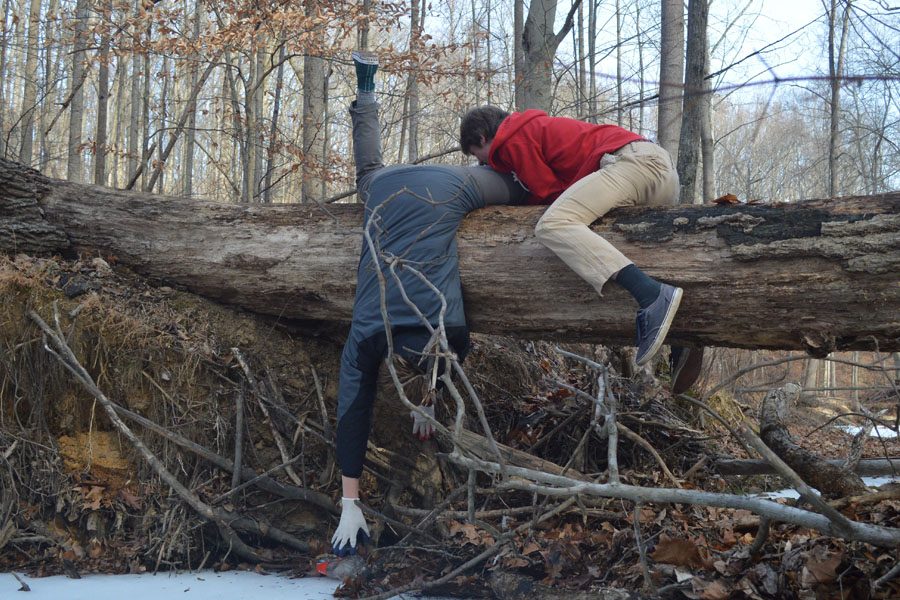School Adopts, Cleans Up Section of Rock Creek
Senior David Barney reaches for a plastic bottle while senior Chris Ribaudo prevents Barney from falling into the frozen creek.
February 13, 2018
After a hike with her family though the Rock Creek trails behind RHS, English teacher Catherine Byrne was disappointed with the amount of litter in the creek. Coincidentally, her International Baccalaureate Career-related Programme (IBCP) students were looking for a Creativity, Activity and Service (CAS) project, which led her to contact the Rock Creek Conservancy. In October, RHS officially adopted a section of creek behind the school.
In 2005 the National Fish and Wildlife Foundation awarded a grant to fund a group that could focus on the overwhelming threats to Rock Creek. In 2011 the organization was renamed Rock Creek Conservancy.
The Rock Creek Conservancy is the only organization dedicated to Rock Creek and its surrounding parklands. Their goal is to restore the 33 mile creek and its surrounding parklands so that it can be appreciated by all visitors.
“Although parkland borders much of the creek, the surrounding development threatens the health and beauty of these natural areas,” program manager John Maleri said. “Rock Creek Conservancy is uniquely positioned to foster outreach, education and efforts to overcome threats to Rock Creek.”
Since the creek is winding, a lot of the trash gets pushed up against the banks and caught in the brush, which makes extraction difficult.
In order to protect these areas, the conservancy assembles stream teams, composed of people who adopt sections of the creek who are responsible for walking the creeks and reporting concerns to Rock Creek Conservancy. They organize trash cleanups and community outreach events. Byrne said she felt creating a stream team for her class’ CAS project would be a great fit.
A CAS project is required in the IBCP program. The students have gone to clean up the creek three times this school year and plan to go at least another three times.
“It’s nice knowing that I’m helping out the Rockville community by picking up the trash, but it’s disheartening coming back a month later and seeing it all there again,” senior Shoshana Wahl said.
About two-thirds of the class goes down to the creek to clean up while the other third cleans up the student parking lot. Byrne said she finds that the parking lot need as much help as the creek.
The most commonly found trash items are plastic bottles, plastic bags and soda cans. Since the creek is winding, a lot of the trash gets pushed up against the banks and caught in the brush, which makes extraction difficult.
Another problem the volunteer students see is that many athletic teams will spell out words or numbers using cups that they push into the fence. Over time, the cups eventually fall out and scatter down the hill. The participating students said they find it irresponsible that the cups are not picked up by the people who put them there.

Senior Shoshana Wahl picks up trash in the student parking lot.
“Not cleaning up the cups causes them to go into the creek behind the fence and can hurt the wildlife when it gets left behind,” Wahl said.
In addition to the project itself, CAS guidelines require students to reflect on the outcome of their project. After each visit to the creek, the students have to write a reflection on what they found, patterns of trash that they’ve noticed and goals for their next visit.
“I learned that there are a lot of polluters out there, and they throw a lot of trash out. It makes me feel angry and upset that they are disrespecting our planet,” senior Matthew Swagart said.
Byrne hopes to take students this year on a field trip to the local recycling center and to the Chesapeake Bay. Next year Byrne plans on continuing to clean up the creek with students and to either increase the number of visits or adopt an additional section of stream.
“I hope they understand that what they do here with their trash and how they live in these eight hours can affect bigger things than them, like our watershed,” Byrne said.




